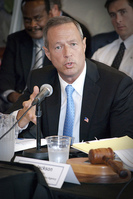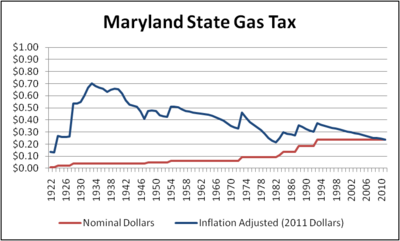O’Malley must step up on transportation funding

Photo by chesbayprogram on Flickr.
Last year, Governor O’Malley supported several controversial issues, including gay marriage and the Dream Act. Now it’s time for him to adopt another courageous stand and support an increase of Maryland’s gas tax or some other method of raising transportation revenues.
According to reports, the O’Malley administration has yet to decide whether or not to push for an increase in transportation funding. Yet the administration clearly recognizes that without an increase in funding, both the Purple Line and Baltimore’s Red Line will be dead in the water.
O’Malley told reporters on Tuesday:
There will come a time when it no longer makes any sense to put any money into the Red Line or Purple Line if the General Assembly wants to pretend we can fund our transportation challenges based on a 30-year-old flat tax on gasoline.
It’s somewhat troubling that O’Malley hasn’t yet decided whether or not it’s worth fighting for these two major transit projects, both of which have been decades in the making. The state is on track (or perhaps, off-track) to run out of transportation money in 2017 for roads and transit.
O’Malley cannot increase transportation funding on his own. No, he’ll need the legislature to also agree. But O’Malley has demonstrated his ability to get things done. In the 2011 session, gay marriage narrowly failed in the House of Delegates. But this year, with the charismatic support of the governor, the bill made it through both chambers.
If Governor O’Malley stands on the sidelines during the transportation funding debate, he might have doomed it, and the Red and Purple Lines, to defeat. But on the other hand, his support could be the crucial factor that makes a deal possible.
Gas tax has mostly declined since 1933
The real problem is that Maryland last raised its gas tax since 1992. Since that time, inflation has driven down the value of the 23.5¢ tax by 36%. In fact, the gas tax has been decreasing ever since it’s high point in 1933, except for periodic raises in the tax rate. In 1933, the value of the tax was 3 times what it is today.
What could Maryland do?
It’s not entirely clear what proposal the legislature will put forward this year.
Last year, the proposal was to do away with the exemption on gas sales from the state’s 6% sales tax. The current 23.5¢ tax on gasoline is an excise tax — it’s 23.5¢ on each gallon. The 6% sales tax is a 6¢ tax on each dollar spent.
The current average price of a gallon of gas in Maryland is $3.26. If gas were subject to Maryland’s sales tax, the cost would increase by 20¢. This would basically double the tax on gasoline. As a result, last year, the proposal called for phasing in the sales tax on gasoline by 2¢ every year for 3 years.
This would bring in a good deal of money for transportation. Another positive impact of this would be to index the gas tax to inflation, meaning that it will lose less value over time.
Another approach that the state is considering is raising the state’s sales tax to 7% and earmarking the increase for transportation. It’s not immediately clear how much revenue this will bring in.
Maryland must act
Doing nothing is not an option. If Maryland does not raise revenues to pay for transportation, the state will be unable to build important infrastructure. For years, O’Malley’s plan to improve MARC has sat on the back burner. Now, the state’s inaction on transportation funding is threatening two more of the governor’s priorities: light rail lines in Baltimore and the Washington suburbs.
Both of these rail lines have the ability to be transformative in their communities. Local officials and citizens have been working since the 1970s to plan for the Purple Line. It would be such a waste for O’Malley’s inaction to condemn this project to the dustbin of history.
And that’s why Montgomery County officials are considering asking the state to give it the authority to levy its own gas tax. The county is concerned that the state legislature will continue to punt on the issue, and they’re not willing to take the risk that one of the most important transportation projects in the region will die on the vine.
This is the time for O’Malley to step up and push the legislature to do the right thing on funding. It will move Maryland forward. And perhaps more persuasive to the governor, it will further bolster his reputation as a doer. Something clearly important for O’Malley’s presidential ambitions.

